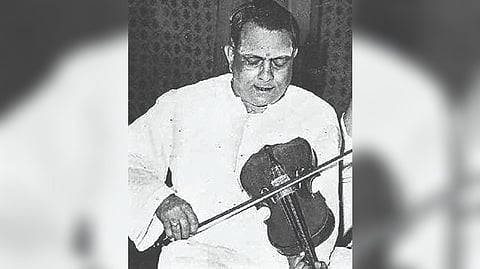

CHENNAI: The family of one of the musical trinity, Muthuswami Dikshithar, moved to Madras with the support of the Dubash Manali Muthu Krishna Mudali. In their spare time, the young composer siblings would trek from Thiruvotriyur to the fort, just to watch musicians of the company band perform on flagstaff road.
Identifying the violin as a potential accompaniment for Carnatic kutcheries, they would request their patron to get them one and a violin was duly imported from Austria. Thereafter it has become an inalienable part of Carnatic stage performances.
Innovation in the violin did not stop and musicians tried modulating the structure of the violin for more unique efforts. Ace violinist from Mysore Chowdiah would introduce 7 strings on a violin and would be ridiculed as “soundaiah” because the vocal musicians thought his 7 stringed violins would drown their sounds on the stage. Forgetting that the instrument by itself was alien to Carnatic art. The 5-year-old Music Academy which had already appointed itself as the guardian and gatekeeper of Carnatic music would take offence. The Music Academy would convene a committee and pass a censure on Chowdiah for using seven strings instead of four.
However, blacklisted Chowdiah could not contain his creative outburst and started performing independently in a rented hall to packed audiences. He would increase the violin strings to 21 and also reduce it to a single one and gather the same applause. Encouraged by the adulation he decided to start a parallel sabha himself. By his side was BV Gopalakrishna Rao who though only a clerk in the corporation had huge contacts amongst the Telugus of Madras. He became the sabha’s founder-secretary and soon the who’s who of the Telugu community flocked to be its members.
The Sabha Gopalakrishna and Chowdiah was founded to break the monopoly of the Music Academy. The Indian Fine Arts Society, one of the oldest music sabhas of Chennai, was established in 1932.
The mercantile Arya Vysya community which contributed many business icons to the city supported IFAS through its philanthropy and headed the committee for decades. Foremost amongst them was the Vupputur family- the pencil magnates.
The annual conferences of the sabhas were literally a show of strength and Music Academy had set the ball rolling, timing it with the Christmas holidays. The IFAS also chose the same scheduling. While Tamil songs were not in the running and it was a free run for Telugu repertoire on the Carnatic stage. The IFAS claimed to counter the Tanjore-centric Telugu songs that Music Academy was leaning towards.
Ironically the society’s biggest challenge came from the man who inaugurated its first conference– Raja Annamalai Chettiar. Perhaps the idea of starting an exclusive Tamil Saba germinated within his mind as he delivered the society’s first inaugural address and the Tamil Isai Sangam was soon born. Recognising the threat, the Music Academy and IFAS would bury their differences and hold joint conferences when the Tamil Isai movement launched its own “pure Tamil in Carnatic” movement.
The IFAS was a low-key participant in the Sabha rivalries and politics. But it took its job as a music sabha seriously. The IFAS would take it upon itself to see that the musical stalwarts ignored by the Music Academy (for non-musical reasons) were honoured. The lecture demonstrations held during the IFAS conferences were of great standard and academicians interested in the theory and structure of Carnatic music flocked there. Above all IFAS was a great talent scout. It was the first sabha to give a chance to MS Subbulakshmi, then a teenager and that too in its first South Indian Music Conference in December 1933.
However, even with cash-rich patrons, IFAS failed to build a hall for itself. While Music Academy and Tamil Isai would have an auditorium each, IFAS could never achieve that dream.
IFAS initially used Annie Besant founded Gokhale Hall on Armenian Street. Annie Besant coincidentally died the year IFAS had its first conference and had a prejudice against devadasi women performing. Even Subbalakshmi’s first concert was held in another minor hall on Govindappa Naicken Street. Whenever the performer list had many from the Isai Vellalar community, the IFAS moved out to some other hall in a black town. Annie Besant’s bias is often quoted by the Isai Vellalar community as a major act by which their art was appropriated from them.
IFAS moved out of black town when black town ceased to be a cultural hub. Now a low-key sabha in the high-volume frenzy amongst many competitors for eyeball space in December, the IFAS should be recognised as an important brick in the musical edifice of Madras.
— The writer is a historian and an author
Visit news.dtnext.in to explore our interactive epaper!
Download the DT Next app for more exciting features!
Click here for iOS
Click here for Android